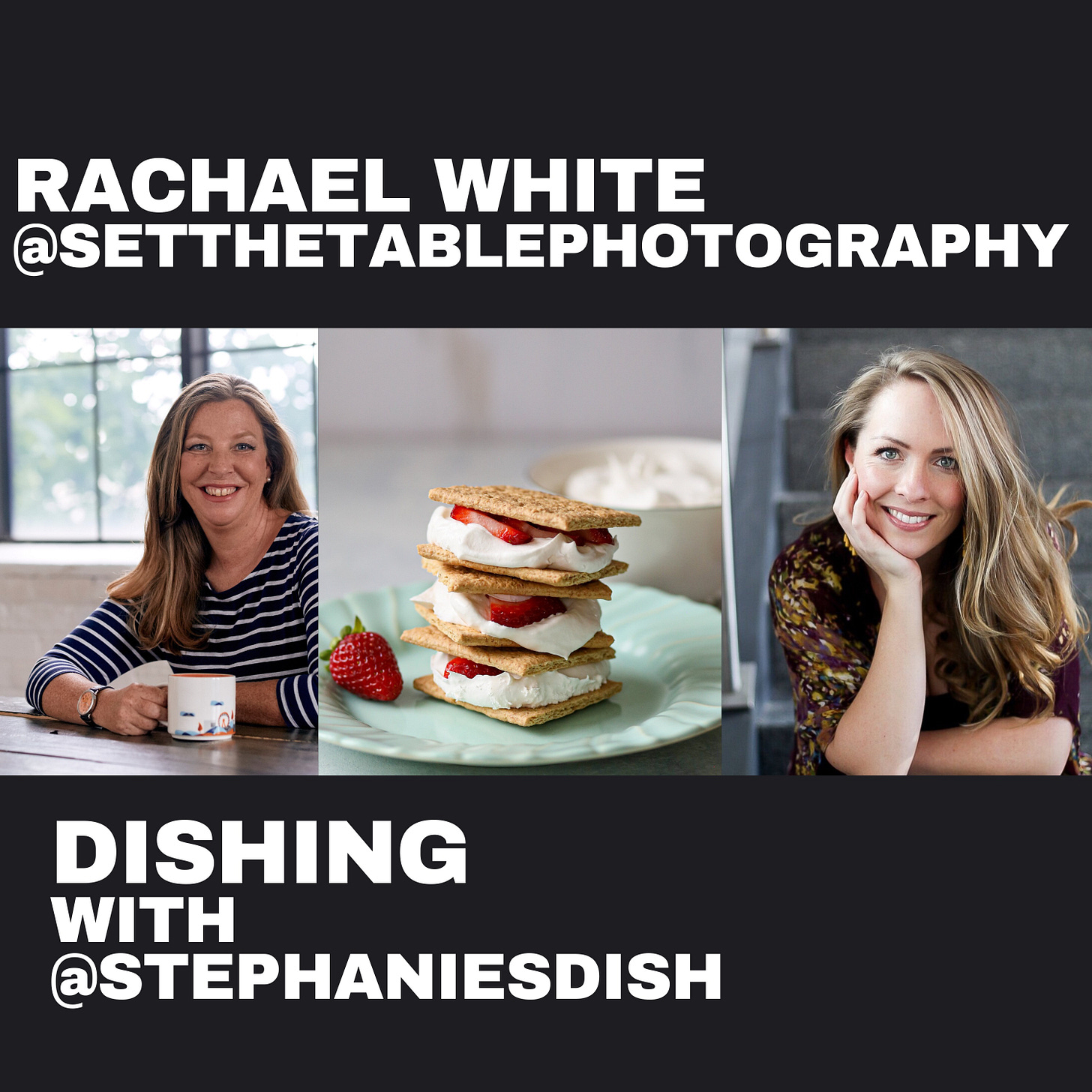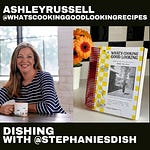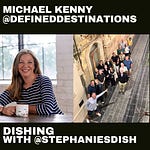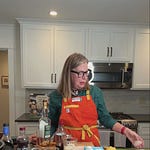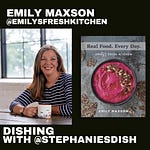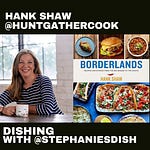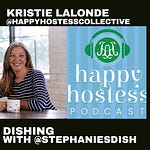EPISODE TRANSCRIPT:
Stephanie Hansen [00:00:15]:
Hello, everybody. Welcome to dishing with Stephanie's dish, the podcast where we talk to people in the food space. And today, I have my friend Rachael White. And, Rachael, you're a fairly new friend of mine that I met on the set of our @fooddolls shoot that we did for the taste buds.
Rachel White [00:00:32]:
That's right. That was such a fun day.
Stephanie Hansen [00:00:34]:
It was fun. And you and I had been followers, but you know how you follow people on Instagram and then you meet them in real life and you don't connect the dots? You have an Instagram handle called @setthetablephotography.
Rachel White [00:00:48]:
Yep. Correct.
Stephanie Hansen [00:00:50]:
So I had followed you. And then at the food doll shoot, they had asked if they could have a food stylist there, and I was like, sure. Yeah. Great. Whatever. That'd be awesome to figure out what food stylists do and how they do their magic. And then you were there, and I didn't put together that you were that person until, like, at the very end of the shoot, which was fun too. Yeah.
Stephanie Hansen [00:01:12]:
You're like, oh, yes.
Rachel White [00:01:14]:
Yep. Yep. So thanks
Stephanie Hansen [00:01:16]:
for being my guest today.
Rachel White [00:01:17]:
Yeah. Thanks for having me. I've been so excited about this.
Stephanie Hansen [00:01:21]:
So you, yeah, you were a real delight to meet on that shoot. And, usually, when we do “Taste Buds With Stephanie” which I should say is the TV show that I do on Fox nine in Minneapolis, and it's also, I think, in other markets. I think we're gonna end up in Chicago and Austin and some other spots.
Rachel White [00:01:39]:
Nice.
Stephanie Hansen [00:01:41]:
We don't have a food stylist on-site. Like, we have a super small crew. We mostly shoot in my kitchen. But in this particular shoot, we were with food dolls, and they were getting ready to promote their new cookbook, Pretty Delicious, which I think it's today. And maybe it was yesterday, but it ended up on the New York Times bestseller.
Rachel White [00:01:59]:
It's like number four on the New York Times bestseller list. It's so fun to watch them succeed with that.
Stephanie Hansen [00:02:05]:
Do you remember at that shoot us talking about that?
Rachel White [00:02:09]:
Yes. I do. Yeah.
Stephanie Hansen [00:02:10]:
And I was like, okay. We are gonna manifest it. We're gonna put it into the air right now because they were saying, you know, well, we would really love this. And for those of you that maybe don't know, presales on a cookbook are really important. And when your cookbook goes live, if you can get enough presales, they all count towards that one day so you can get on the New York Times bestseller list. Now food dolls with 8,000,000 followers are in a trajectory of their own and will probably stay there, I imagine, for some time. But for the rest of us, we would just be like, yes. I could get there once.
Stephanie Hansen [00:02:44]:
Yep. So, Rachael, talk a little bit about what a food stylist does or what your trajectory was. Well, two things about how did you get here and then what's your actual job.
Rachel White [00:02:57]:
Sure. So I have I mean, as I think a lot of people do in the food space, I have a very nonlinear storyline of how I got here. I actually majored in communication and music in college thinking I'd do something in one or both of those areas. And, a year after my husband and I met in college, we got married a couple years after graduation. And then a year after that, we ended up moving to Tokyo, Japan for four years. Which I know you were just there.
Stephanie Hansen [00:03:26]:
I was so pumped so much.
Rachel White [00:03:29]:
And when we went there, I did not have a job. So my official title was trailing spouse. And it's like the worst title ever. It's like I hate everything about this. But my husband was teaching at an international school and I just kinda was hanging out. Like, I did some subbing, didn't have anything else going on. And, hilariously, I bought my husband's name is Brad. I bought Brad a camera and I was like, you know, he he loves taking pictures.
Rachel White [00:03:57]:
He's gonna have so much fun with this DSLR walking around the city, taking pictures of stuff. But, of course, he was working all the time, and this camera's just sitting there collecting dust. And I was like, I'm just gonna pick this up. And I started photographing our food that we were eating, you know, when we'd go out, but mostly when we were just cooking at home. So I put together these dishes and take pictures, send them to our family. And then I started a food blog called Tokyo Terrace and started sharing everything on there. And that was kind of where things began for me. So the ball really started rolling at that point.
Rachel White [00:04:32]:
I got a recipe published in, the daily Yomiuri which is like the one of the newspapers in Japan and that was really exciting. And then from there I sort of went back and forth between do I want to be a food blogger or do I want to really focus on the more creative side of things. And, you know, I had one of my kids in Tokyo. He's just turned 13. And then I had another kid three years later. And, you know, I I was all over the place. So I didn't really have a whole lot of direction for a while. We also moved a couple times in there.
Rachel White [00:05:05]:
And then in the last couple of years well, I should say, even though things were not consistent at that point, I was always involved in some kind of food styling or photography because it just it was something I couldn't not do. Like, I had to be involved in it somehow. It's like my life's breath to make food beautiful and I love capturing that in any space really. It can be the fanciest like five star dinner somewhere out or it can be like the most humble thing that I made at home like a boxed macaroni and cheese with like some fun stuff on top of it. I just love making stuff look pretty. So that is kind of how I got to where I am now which is I am focusing largely on food styling and I do some food photography. I do a lot of food styling assisting for other stylists in the Twin Cities area. And so, when I do that kind of work, my job is basically to do, some of the grunt work for them.
Rachel White [00:06:05]:
So a lot of the little things so they can have, like, a bigger picture of what a dish is gonna look like. And then, you know, I get the job of like, I've sorted tortilla chips before and like taken out the broken ones. So that's one aspect of my job. But again, it's like the whole point is just to make food look as appetizing as possible. So you want somebody to look at it and say, I need that. Like I need to put that in my mouth. And then another part of my job is I do freelance food photography and styling like as a package deal. So food bloggers will sometimes send me their recipes and I will photograph and style them in my home.
Rachel White [00:06:40]:
And in that case, it's oftentimes old recipes that they want revamped, so that they can post some fresh photos of it. And sometimes it's new recipes too, but that's always something that I really I love doing that since my roots are kind of in the food blogging space.
Stephanie Hansen [00:06:57]:
And, yeah, I think people don't realize that a lot of the Google AdWords algorithms and the things you click on, they're we're always in a chase to
Rachel White [00:07:09]:
make
Stephanie Hansen [00:07:09]:
our content stickier, let Google see it more.
Rachel White [00:07:12]:
Yeah. Yeah.
Stephanie Hansen [00:07:12]:
Requires, like, updated photos, updated text, variations, add ons. All of those things over the course of years keep that site stickier and those recipes more attractive. So Yep. You know, creators, like, I don't wanna go back and make something necessarily that I've made 62 times.
Rachel White [00:07:33]:
Mhmm.
Stephanie Hansen [00:07:34]:
So it's fun to sub that out, I guess, as it were.
Rachel White [00:07:37]:
Yep. Exactly. And I found too that a lot of, you know, food bloggers or recipe creators who have a website, there's so much that goes into that, that most people don't see. Like I think if you're inexperienced in that area, you just assume that it's mostly just cooking and photographing the food and then writing a blurb about it. But there is so much behind the scenes that they're doing. And a lot of people are just like, okay, I need to offload this photography piece so that my brain power can go to some of these other things like SEO and my Google ranking and, things like that. So it's really fun to be able to step in and say, like, I got you. Like, let's let's do this together.
Rachel White [00:08:18]:
I I get to do what I love to do, and they can focus on where they feel like their strengths are. So it's really fun.
Stephanie Hansen [00:08:23]:
It is this whole crazy space because I started like you started where I just started, like, taking pictures of food, and I was making recipes that I liked. And I was recreating some of the stuff that our family made. My mom had died, and I was, like, trying to refigure out how she made her meatballs and that sort of thing. And then you're like, oh, this will be fun. Let's just start documenting and blogging. And then it becomes more fun. And, also, like, at some point, if you get any work in the space, now it becomes a job. Yep.
Stephanie Hansen [00:08:58]:
And then that job grows, and then you start to find yourself like, you have this imposter period of time, right, where
Rachel White [00:09:07]:
Yeah.
Stephanie Hansen [00:09:07]:
You're just, like, doing this job, but you can't believe people are really, like, paying you money to do this job. And then, like, the cookbook things happen and the social media things happen. And I am having this real world experience in that I'm, like, backing in now to all the stuff I didn't know, like all the SEO and, oh, you need six images instead of just one. And I was so focused on getting one good image. Now, you know, they're asking me for six. I'm like, holy Palomino. I don't know. Yep.
Rachel White [00:09:38]:
Yeah. Yeah.
Stephanie Hansen [00:09:40]:
So it's just I'm I'm almost for me personally, I'm, like, backing into trying to be a professional. And, also, like, there's so much about creating that's fun. And when it gets unfun, I get real just like, I don't wanna do that.
Rachel White [00:09:55]:
Absolutely. Yes. Absolutely. And I think you mentioned, like, that feeling of, oh my gosh. I'm getting paid to do this. Like, what the heck? And, like, when I started doing photography and styling and actually getting paid for it, that was back in, like, 02/2013 was when I I started this whole thing started in, like, 02/2008 for me. And then by 02/2013, I started getting hired for things. And, hilariously, like, my first job, it was like, we'll pay you $25 a month for one recipe a week.
Rachel White [00:10:28]:
And I was like, yes. Let's go. Excited about it. But then, you know and like you said, like, once it starts feeling like as worth of your time Right. It starts to get harder. I feel like if you don't put a high enough value on it, it all starts to it takes away the joy that you feel doing it just in your free time even because you just feel so bogged down. And, like, it does. It takes a lot of time and resources, and you are always learning.
Rachel White [00:10:57]:
And that takes time and money to be able to put, you know, the effort into that. But it's tricky. And it's hard when there's so many people, like, way back when I started agreeing to something for $25 a month. Like, I don't regret it because it gave me a really good experience and a better understanding, of how to put of of how to value my time. Yeah. But, you know, it's tough because there's a wide range out there.
Stephanie Hansen [00:11:24]:
And now, like, I don't know how you do your accounting, but the food Like, I just was looking year over year. Food costs have increased in the Twin Cities, 22%.
Rachel White [00:11:37]:
Yep.
Stephanie Hansen [00:11:38]:
So in some of my arrangements, you know, I just buy the food, and then I make the stuff, and it's all based in my pricing. But food is getting to be so much. I'm having to really calculate that in and how we're moving. Do you usually calculate food in? Or do you
Rachel White [00:11:54]:
Oh, I, I typically will say, like, unless I have everything on hand, I will have whoever I'm doing the work for reimburse me for groceries. Yep. It just is easier that way because, yeah, it does get really hard. You know, people say, well, don't you just eat all the food that you, you know, but no, like, I don't.
Stephanie Hansen [00:12:14]:
A lot of times when you're done working
Rachel White [00:12:16]:
on it, you're done. You're wanting to get it. Yeah. Exactly. Exactly. And like, you know, I have a family of four and not everybody's gonna eat everything that I make. And so yeah. So I do I do ask that my clients reimburse me for the groceries.
Rachel White [00:12:29]:
And, you know, sometimes they'll tell me, like, I'd rather, like, have an Instacart delivery sent to your house or something, and they'll just do it that way. But, yeah, that seems like a pretty like, an easier way to go about it, especially as prices are changing because then they can kinda say, like, well, do I wanna release control of that? And does that change what I wanna do or, like, what I want to use in the recipe or whatever? But, yeah, that is definitely a challenge, and I don't think that's gonna go away anytime soon. So,
Stephanie Hansen [00:12:57]:
So in your work, like, what can you put a percentage on, like, I just had this idea that most of the people that were hiring you were, like, brands, like food brands. And it sounds like you're getting a significant amount of work too from the bloggers themselves.
Rachel White [00:13:12]:
Yeah. So I right now have two very consistent food bloggers, that come to me pretty much every month to have me do recipes for them, which is lovely. And then I also recently just got hired at Land O'Lakes as an on call photographer for them. So that's been really fun.
Stephanie Hansen [00:13:32]:
Yes.
Rachel White [00:13:33]:
So it's nice to have the, kind of the juxtaposition of such different areas of food because I feel like that helps me make some connections. It helps me learn a lot. It really, like, keeps the job interesting because those are two very different things. Like, the stuff that I do at Land O'Lakes is completely different from what I do for these food bloggers, but it's all just so fun. I just love it.
Stephanie Hansen [00:13:55]:
When you go to, like, a Land O'Lakes shoot, for instance, traditionally, how many people are in the room working on that piece of food?
Rachel White [00:14:05]:
So, I'm I'm, like, three weeks into it right now with them. And they've got such a for the type of photoshoots that we're doing, they have such a wonderful team of people, and most of them are on call. Some of a lot of them are recipe developers by trade, and then they come in and help with the styling. And so we all kind of have our hands in the styling piece of it, which is actually really great. But I'm trying to think. Like, today, we had one, two, three, four, like, four main people working on stuff, and then we had a couple of, assistants who were helping with, like, cleanup and all of that. So, I mean, it's a it's a nice sized group, and, it's more of a relaxed setting for what we're doing. So it's not like a huge studio shoot.
Rachel White [00:14:52]:
I've been on a target shoot where it's like, there's, like, 20 people in here and I don't know.
Stephanie Hansen [00:14:57]:
It's so crazy because, like, we're filming this TV show and we literally have, like, three people
Rachel White [00:15:04]:
Uh-huh.
Stephanie Hansen [00:15:04]:
And myself, and that's it. And it's just we're taking the pictures. We're doing the styling. It's just it's crazy how it all works. Yeah. Do you enjoy taking photographs or food styling more?
Rachel White [00:15:18]:
Oh, that's such a good question. Oh, it's so hard. I do really love both. I think some of it depends on the situation. But if I had to really pick one, I'd probably say that I enjoy the styling part more. I think I've just always had this thought in my head, like, you eat with your eyes first. And so no matter what I'm doing, whether it's for work or otherwise, I'm always trying to make it look as pretty as I can, which sometimes is a huge challenge, you know. Like, I was photographing lentil soup a couple years ago.
Rachel White [00:15:54]:
It's like, everything's brown. Yeah. I don't know what you can do with this. But in the end, like, the it ended up looking really beautiful just from a little, like, a little garnish of parsley and, like, you can add just these little tiny things that just take it from being something totally boring and uninteresting to all of a sudden, like, you can imagine taking a bite out of that bowl even if it's just on your computer screen. And I think there's something so just fulfilling about that, and being able to, like, see the difference that you can make with just these little touches. And I think some of that is I've I've always kind of dabbled in art, and I think that being able to bring that into food styling just makes it so special. I love it.
Stephanie Hansen [00:16:39]:
When when you're, like, having a dinner party or when you're at home, like, just cooking for your family, are there, like I don't wanna, like, break it down to, like, tips necessarily. But to make the food look prettier, are there, like, some go to hacks that you have?
Rachel White [00:16:56]:
Yeah. I think one of the best things you can invest in is serving platters that are simple. You don't want them to be too detailed. You don't need a bunch of stuff on them. Like, just have a few go to platters that you can use, like, for pasta or salad or because a lot of those you can use for multiple things. Right? So people are like, well, what do I use this this giant bowl for if I'm not putting salad in it? Well, put, like, a bunch of noodles in there or I you know, pile up some, like, grilled chicken or something. Yep. But have some pieces that you really feel, that feel like a blank canvas.
Rachel White [00:17:31]:
So when you put your food on there, the food really pops and stands out. You don't want something that's gonna take away from what you're serving because then everybody's gonna be focused on the plate and not on your beautiful food.
Stephanie Hansen [00:17:42]:
Right.
Rachel White [00:17:43]:
So that would be one thing. The other thing is, don't be afraid of color. So, like, if you are serving something that and you're just like, blah, like, what is happening here? Don't be afraid to add even if it's not originally in the recipe, like, add parsley, add cilantro, add like, if you do some parsley and, like, red pepper flakes on top of something, even just a little, that just that little pop of color can make all the difference.
Stephanie Hansen [00:18:09]:
When we were together, you, like, sliced some scallions, and, you know, I would just chop up and down. You kinda sliced them on the bias Yep. And then threw that over, and it just that little cut made a big difference.
Rachel White [00:18:25]:
Mhmm. Yeah. And I think thinking about kind of thinking outside the box. Like, how can you prepare something a little differently so that it's a little more unique? Like, one of my favorite tricks is in coleslaw to make carrot ribbons. So you just take, like, a vegetable peeler and make long ribbons out of your carrot and then like toss that in with the rest of your coleslaw. And instead of it all being those little matchsticks Yep. It just adds another layer of like texture and color and it kind of adds some variety that you wouldn't normally have. So, yeah, just kinda thinking about different ways that you can mix stuff up, I think, is always great too.
Stephanie Hansen [00:19:00]:
Are there people that you follow on Instagram that you're just, like, obsessed with? Or do you have to almost not look because you don't wanna steal looks?
Rachel White [00:19:11]:
Yeah. It's it's hard. I think I it's not that I don't follow people because I'm worried that I'm gonna steal their look, but it's more because of the imposter syndrome stuff that can really creep in. Yeah. I think at one point, I was following so many food photographers and stylists, and I was just, like, inundated with everything. And I just felt like I can't find my style when I'm just consuming everybody else's. Yeah. And so I had to really take a look at that pretty closely and try to figure out, well, what other influences can I bring into my social media life that will help me in my work? And so I follow some people who, like, do watercolor tutorials, post about flowers, you know.
Rachel White [00:20:00]:
And just, like, adding that variety just helps with my creative brain so much. Yeah.
Stephanie Hansen [00:20:07]:
My husband's a writer, and when he's working on a book, he, like, will only read nonfiction because he doesn't wanna get those fiction voices in his head, you know, like and and the algorithms, you know, the more you look at something or follow something, the more it serves that up to you. So it's kinda hard to get out of that spiral. And, like, food is trendy too. You know, we're kind of in this space where a lot of people like, I'm just trying to think of, like, food styling. Like, you know, we had the swash of the hummus, and then everything was piled up on the hummus. And that was for, like, a swash of mashed potatoes, a swash of squash. It was just the shoosh, and you would see it in a restaurant, and then it started to get into the books.
Rachel White [00:20:56]:
Yeah. Yeah. So it's really easy for ideals like that to stick, which is not a bad thing. And I think, you know, there's a point where, obviously, if you're straight up copying somebody, that's not okay. But taking influences from other people's work, that's kind of how creative work becomes something new. You have to take something that's already existed and build on it. Yeah.
Stephanie Hansen [00:21:21]:
It's hard to do that too. And I think about that. Like, sometimes I panic with recipes because it's like, did I see this somewhere? What was it the same? Was it like that? Like, it's it's kinda hard to know. And in my first book, I was sort of paralyzed because I was doing a lot of our family's recipes. So it was like, here's Janice's potato salad. You know, can I actually make a change to her potato salad? And was it her potato salad, or where did it originally come from? And Mhmm. Something becomes your own. It recipes just in and of itself are kinda hard to track that way.
Rachel White [00:21:59]:
Yeah. It is super hard because it does feel like, well, everything's been done. It's how it feels. And we're making these little tweaks to make it our own, but it still feels like, nope. This belongs to someone else. And I've had this happen with my own recipes. And, you know, we're all I have developed a recipe and it's been around for a while. And then all of a sudden, I'll see I'll see something somewhere else.
Rachel White [00:22:22]:
And I'm like, that's literally the exact thing that I made Yeah. Forever ago, which it used to bother me. But now I'm like, no. You know what? That's there are only so many combinations of stuff, you know. Yeah. And part of the reason we come up with these ideas is because they work. And, you know, when you put flavors together that make sense, like, somebody else is gonna think of it too, and that's okay.
Stephanie Hansen [00:22:46]:
Yeah. And also, like, I don't know. We haven't had all these discussions about cultural appropriation of food. Yeah. Like, if you I'll just use, a taco, I guess, as an example. So if you're making, like, what they call the gringo taco, which is sort of the ground beef, the white flour tortilla, lettuce, and tomatoes, and you then if you decide to make, like, a more authentic taco, maybe you're gonna do, like, a pork carnitas, and you're gonna have cilantro and pickled red onion and pickled jalapeno. You are you appropriating a culture that that originated in? And I'm glad I personally have a really hard time with that because food is medicine, and food is life and has been for since the beginning of time. And, yes, every culture has a way of making something their own, but, like, just the idea of what is a taco, whether it's a corn tortilla, whether it's a pita, whether it's a a seaweed wrap.
Stephanie Hansen [00:23:49]:
I mean, cultures have wrapped food in various things since the beginning of time.
Rachel White [00:23:54]:
Yep.
Stephanie Hansen [00:23:55]:
I don't wanna really get hung up on who's who made the original taco. And, you know, I just I think it's gotten so hard. We're a global world. We're a global economy. Yeah. We're globally influenced by food.
Rachel White [00:24:09]:
And it is. It's very tricky. I I have I'm not ashamed to say been called out for posting a recipe and trying to say, like, you know, I ate this in this country and here's my version of it. And I faced a lot of backlash for it. And I I think we're in a we're in a period of time where it can be very easy to freak out at other people, and I don't think that that's always wrong. I think there is a productive way to go about it, and not everybody is able to do that. But I think as long as it's coming from a place of, like, hey. I'm just gonna let you know, like, here I'm from this place, and I grew up there.
Rachel White [00:24:53]:
I understand this dish that you have posted the recipe for. And, like, here are some things that you missed. You know? Yeah. But I literally, like, was getting death threats threats from people for this recipe.
Stephanie Hansen [00:25:04]:
That's crazy.
Rachel White [00:25:04]:
And it's like, I I I fully was ready to, like, learn. I was like, okay. Great. Can you tell me how I how can I fix this so that it's more authentic? And then I just never heard anything back, which was such a bummer because I think if you're open and, like, willing to say, like, I messed up, but I wanna make this right, and I wanna make sure that I learn what it means for this recipe to be authentic. I think that we should be able to say, like, okay. Like, let's have an open conversation about it. But you're right. I think when it comes down to something like a taco that's just ubiquitous, it's really difficult to say, like, well, we're gonna really narrow this down and we're gonna say, like you know, you have to give all the details about where it came from and what year.
Rachel White [00:25:48]:
And I think a lot of that is really useful to learn about and also, you know, there's a way to do it that is effective.
Stephanie Hansen [00:25:56]:
I had to actually this is kind of a weird story, but there's a person that follows me on different, channels and different TV things that I've done, and they're always freaked out that I'm not wearing my hair in a ponytail or wearing a hairnet when I cook on TV.
Rachel White [00:26:13]:
Yeah.
Stephanie Hansen [00:26:13]:
And I get it. You know, as a chef, they'll always start out, like, as a as a chef. Well, when I am making food on TV, I am there as a person that's supposed to look good on TV. And I'm not cooking in a professional kitchen, and I'm not cooking food that anyone is gonna be eating, actually. So I'm there with my full hair trying to look like a attractive person on television that you wanna watch make food. If I were to show up with my gloves and my hair net, that wouldn't be the same experience. And while it maybe bugs you, I get it. But you have to, like, think of the context of the which I'm preparing this food.
Stephanie Hansen [00:26:53]:
When we're on the TV show and we go into a professional kitchen, I do put my hair up because that's the standard that they have in their professional kitchens, which I understand. But, like, every post, this person is just like, can you put your hair up? I don't understand why you don't have your hair up. It's gross. I don't wanna get hair in my food. So, finally, I just, like, sent them an email. Oh, actually, no. I blocked them on Facebook. Uh-huh.
Stephanie Hansen [00:27:15]:
And then they sent me an email saying the exact things that they've been saying. And I, like, was like, do you realize that you're at this point bullying me about not wearing my hair in a ponytail on television? And let me explain for the hundredth time why I'm not, and I'm not going to. And by the way, do you watch Rachael Ray, Ina Garten, Giada, the pioneer woman? I mean, these are also people on television. We're not preparing food in a commercial kitchen, and your inability to let go of it is now becoming something about you that I need to block, and I need to stop having this conversation. And you are bullying me about this, and I'm done. And she replied, and she was like, oh my gosh. I didn't realize how this was coming across. And okay.
Stephanie Hansen [00:28:02]:
Maybe you didn't. I'll give you that. But I'm also done having this conversation with you. And if it bugs you so much, you shouldn't watch. Mhmm. Exactly. Yeah. And it sounds like maybe
Rachel White [00:28:13]:
she doesn't watch too many other personalities on screen.
Stephanie Hansen [00:28:16]:
Even know. I just was like, I cannot keep having this conversation, and you bring me down every time I open up this email. So stop. So, hopefully, now it'll stop. Yes. And so that was kind of a long way around, which is to say that we're in a creative business doing lots of cool creative things. I I really enjoyed working with you on the food doll shoot. Yeah.
Stephanie Hansen [00:28:36]:
That was such
Rachel White [00:28:37]:
a great day. And that was the first time I had styled anything for a show. So that was really fun for me to get to do because we did a couple shows after that, and I tagged along with them to help style their food for some other well, we were on the Jason show. Yep. We they were on the Jason show.
Stephanie Hansen [00:28:52]:
What did you make on Jason?
Rachel White [00:28:54]:
That was their, Greek cowgirl caviar. So good. I had it I had a bunch left over after we made it, and I had it for lunch, like, every day that week. And it was Yeah.
Stephanie Hansen [00:29:05]:
They have really good simple food, and their book is pretty delicious. Are you still posting on Instagram, and where can we follow you to stay up to date?
Rachel White [00:29:15]:
Yes. I do still post on Instagram. That's pretty much the only place that I update almost anything at the moment. But but, yeah, please please give give me a follow if if that's interesting to you.
Stephanie Hansen [00:29:25]:
It is. Set the table. Do you feel pressure about, video?
Rachel White [00:29:32]:
To start doing video, you mean? You know, I did for a little while, but I don't anymore. I think there's a point where you have to say, like, it's not that I don't wanna learn new skills, but I also know when to call it. Like Yeah. And you're I don't need to branch out like that right now. If it becomes that way, then maybe I'll change my mind. But I am very thankful to be working with a lot of women that I really admire. And as long as I get to continue working with them, I am very happy with the skill set that I have. And I'm so thankful, to have all of those influences around me all the time.
Rachel White [00:30:14]:
Like, positive female energy is just there's nothing like it. So
Stephanie Hansen [00:30:18]:
Yeah. It's funny too. Like, I just think back to that food doll shoot because we've stayed in contact. Mhmm. They've helped me with a couple things. I've given them some advice on a couple things, and they were so delightful just as people. It was great to meet you. You know, you do a lot of this work solitarily in your kitchen or alone, and then you get out into these spaces and you actually meet people.
Stephanie Hansen [00:30:41]:
Oh. And you're like, oh, this is so great. They're so nice.
Rachel White [00:30:45]:
Yes. And I think that's been the nicest thing for me over the last couple of years because, you know, we so we lived in Japan, and then we lived in Colorado, and then we moved back to Minnesota. I grew up in Minnesota, so it it was coming home for me. But, we've been back here for six years, five years, something like that. But then, you know, we moved back in 2019, and then COVID happened, like, a year later. And I just had felt very disconnected. And I'd been watching this amazing food scene in the Twin Cities and just, like, for a long time, I'd been kind of watching it from a distance. And then we moved back, and I was like, oh my gosh.
Rachel White [00:31:21]:
I'm gonna get to connect with these people in real life. And then stupid COVID happened, and everything, like, got stalled. And so the last couple years have just been so lovely because I really have been able to make wonderful connections, like, with Alia and Radwa and with you. And, you know, it's just been, like, life giving. And I just appreciate it all so much. And, you know, since we've been talking about the food dolls, they're just they're, like, such warm people. Like, I know people on social media have to have, like, a certain way about them. They're like that in real life.
Rachel White [00:31:58]:
Yes. Like, they're just warm, lovely people. Yes. And, like, from day one, they're like, hug. Yep. And I was like, deal. I think we're gonna get along just fine. Yeah.
Stephanie Hansen [00:32:08]:
And I felt that way about you too. Like, when
Rachel White [00:32:11]:
So comfortable with you as well. Yeah. Yep.
Stephanie Hansen [00:32:14]:
And it's fun. It makes the job fun. And as creators, we need to stick together because we're all in this kinda weird space, and it can be a little isolating at times.
Rachel White [00:32:26]:
Yeah. Yeah. Yep. So it's
Stephanie Hansen [00:32:28]:
really fun to check.
Rachel White [00:32:29]:
A lot of the imposter syndrome stuff comes from is because it's often such an isolated experience, and you just get stuck in your own head. And then the more you're around other people, I think the more comfortable a lot of the time you end up feeling.
Stephanie Hansen [00:32:44]:
Yeah.
Rachel White [00:32:44]:
And I would have thought it would be the opposite. For a long time, I think that's how I felt. I was like, well, I'm just gonna keep doing my own thing at home because it feels less scary. But it turns out, like, when as soon as I stepped out of my comfort zone and started actually, when I started assisting, food styling assisting, and that got me out of my home, That changed everything for me. It's been I've I've worked with Marin Ellingbo King a couple of times, actually quite a few times, and Brooke Faudree. And it's just like just these people who are so talented and so wonderful. And I've just learned so much from all of them. It's just such a treat.
Rachel White [00:33:23]:
I love it.
Stephanie Hansen [00:33:25]:
Well, it's been a delight to talk with you today. Thanks
Rachel White [00:33:27]:
for being
Stephanie Hansen [00:33:28]:
our guest. I'm sure we will cross paths again soon.
Rachel White [00:33:31]:
I hope so. We better.
Stephanie Hansen [00:33:33]:
Yeah. Maybe I'll start sending you recipes. I just Do it. I, I got my book today in its first form that I'm seeing, like, the pictures and the recipes altogether. And I was thinking about you because you were such a good food stylist, and I've been doing it all myself. And this is the last book I can do it myself because it's sort of a cabin y, rustic type book.
Rachel White [00:33:53]:
Sure. Yeah.
Stephanie Hansen [00:33:54]:
But I was like, oh, okay. This is the last one you can photograph yourself, Stephanie.
Rachel White [00:33:59]:
Well, I'm there for you. So
Stephanie Hansen [00:34:01]:
I appreciate it. Alright. Thanks for being my guest today, Rachael. Thanks so much, Stephanie. Alright. And I'll put your, Instagram handle in the notes, and people can follow you at set the table photography. Correct?
Rachel White [00:34:12]:
Perfect. Yep.
Stephanie Hansen [00:34:13]:
Alright. We'll talk to you soon.
Rachel White [00:34:15]:
Okay.
Stephanie Hansen [00:34:15]:
Thanks. Bye bye. Bye.


